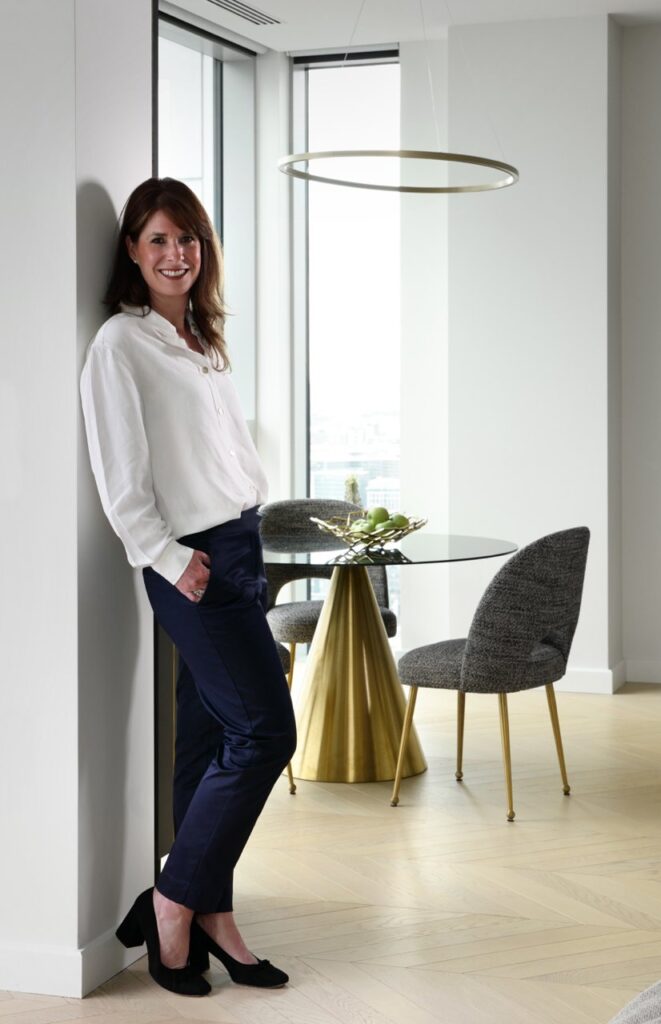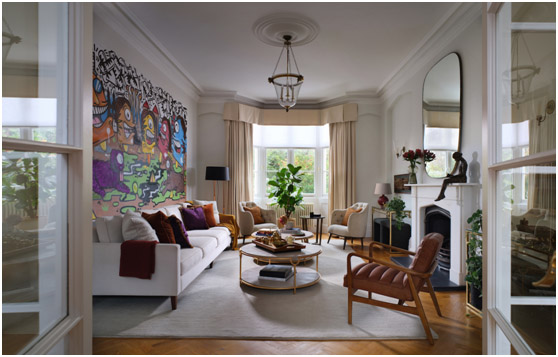
Some of the most common questions we get asked are those relating to the timeline of a project. Planning the timeline of a project is super important as we contend with the ebbs and flows of the calendar year – school holidays in the summer, study leave or exam period from late Spring to early Summer, holiday plans with family and friends over the winter… These are all things we need to consider when it comes to renovation or building work, as well as smaller projects like reflooring or refurnishing. Read the Q&A below to get a better understanding of project timelines!
What are the typical phases of an interior design project, and how long does each phase usually take?
There are four stages to each project, see a breakdown below. It can take 6 months from the first phone call consultation to the end of the project:
Stage 1 – Design phase
- This is usually between 1 and 2 months, depending on the size and scope of the project. Something like just a primary bedroom, or reflooring would be on the lowest end of the range – 1 month. For an entire large house, this phase could be up to 2.5 months
Stage 2 – Budgeting
- This is a short stage, usually between 2 and 3 weeks, in this stage, we work on budgeting for the materials, labor, furnishings etc.
Stage 3 – Procurement
- This is the longest stage of the project, typically ranging between 3 and 4 months. This stage is longer because deliveries of larger furnishings like a sofa can take 8-12 weeks, so it’s good to get this kind of thing ordered as soon as possible. This stage also includes building works which usually takes around 12 weeks, which includes 2 weeks of installation and 2 weeks templating of the stone – so 4 weeks once materials have been delivered. This timeline can be reduced if you are buying materials off the shelf rather than having all stone custom made
Stage 4 – Finishing touches
- The shortest stage, usually around 2 weeks. At this point, the client is already living in the property and can see if anything needs any finishing touches or if they are waiting any replacements for items damaged in delivery. We can work with an art consultant at this stage and can do any installations of smaller pieces and hanging of art
Check in (stage 5)
- This is a post stage of the project. 6 months after a project is completed, we often recommend that the builder come again to touch up anything needing retouching (sometimes walls need to be retouched after all the deliveries). Once the client has had time to live in the property and share any notes on anything that isn’t working properly and we can have it revisited
- This is also the moment to add anything that the client feels is lacking – recently, I had a client want to add more bespoke rugs as we only started with one. More art can also be added as clients often take more time with acquiring art
How do you determine the overall timeline for a project?
We try to break it down to give the most accurate sense of a timeline, but we are good at predicting how long each stage will take. Sometimes we can target some rooms to be ready in time for Christmas, such as the dining or living room, and then take a pause for the holidays and tackle the other rooms after. We don’t want you to be living in a building site, so we can prioritize and divide and conquer in ways that make the most sense for your timeline. We want the process to be the least invasive as possible for our clients, as the excitement of having builders in and out can wear off. We are very conscious of keeping to a tight timeline for this so that the project remains efficient and livable while it is in progress!
What factors can influence the length of each phase?
The speed of decision-making from the client is the biggest factor. Some clients are very quick, others need much longer to weigh up different options. It is important to be swift and not linger too much so that things remain in stock. Otherwise we risk stock running out, or builders and carpenters accepting other jobs. We also need to be aware that there can be delays in deliveries.
Which time of the year is quickest?
The end of September is a time where projects tend to move quickly, and often projects are done in time for Christmas if we start towards the end of the summer. Projects slow down after the Christmas holidays, and start speeding up again in March, and we are at our busiest in April/May.
When is the best time to start a project?
Some general advice is that if you’re terrible at making decisions, start as early as possible, as during a project we will come up against various decisions throughout the project. For many this is fun and engaging, and making choices quickly will help speed things up. If you are on a tight schedule – a baby is coming, or parents are coming to stay from overseas for a length of time, or you’re hosting a large event – it’s also good to start a few months before you would expect just so there is no room for disappointment.
If there is a point in the year in which you don’t want any interference, e.g. study leave for kids, we need to be aware so we can plan accordingly. It might be helpful to keep in mind that GCSEs finish at the end of June, at which point a lot of projects slow down as people go away on summer holidays. If we don’t put a project on pause during the summer, it’s important to be open-minded about delays as it is a period in which suppliers are much slower. Starting to think about our timeline as early as January/February can allow us to have everything planned and booked in, with well-managed expectations.
Or, to give another example, if you want your house complete for Christmas, work backwards 3-6 months depending on the size of the project; if you want to host a Christmas lunch without panic, we would start building works early September. Which would mean we’d start planning in June!
Can you walk us through the initial consultation phase and what clients should expect during this time?
You can book a complimentary consultation via website, here – this is a free 30-minute for free, but we always ask to be sent images and floorplans of the space before so that we can really discuss the brief and what you want to do
After this point, if you might be ready to do a proper consultation – and we don’t have to be on site to do that, it can be done over zoom. This is more about getting to know the client – we go through a color, style and furniture questionnaire. If it is a couple, it’s good to make sure both people are present. Most clients really enjoy this stage as they get to know themselves and one another, as we get to know you!
A consultation tends to be between 1.5 and 3 hours, but there is no stop watch and we can take as long as we need to get a complete sense of the scope of the project – some people are very quick, others take longer if they like a more discursive discussion.
After the consultation, we write up a brief, and then we have another meeting to go through the proposal, in which we can make amendments. Sometimes we decide to break the project up – we can start out doing a room or two, and then extend to further rooms if we are working well together and it’s a good fit.
How do you manage and coordinate with contractors and other professionals to ensure the project stays on schedule?
The most important thing is to draw up a strict timeline and communicate it to everyone involved in the project. We have always been excellent at project management. We give any contractors a tender pack, all our drawings, and have a meeting with them so they know when each stage is due – flooring, moulding, skirting boards, cornices. For example, when we will coordinate when the site will be ready for the kitchen so that we can coordinate with the kitchen company. Then we coordinate with the carpenters when the space will be ready to install smaller installations like a TV unit / walk-in wardrobe.
What role does client feedback play in the timeline, and how do you handle revisions and approvals?
Client feedback always plays a big part in the timeline. When we present our ideas we always have two or three different options of layout for the space. We give at least three options for large furnishings – sofas, armchairs, rugs. From this presentation, clients can make their decisions. We then do another presentation with their options. After that point revisions are more complicated so we cannot redo the whole concept. From beginning of project, we really can tell what you like and analyze your taste really well – we know what can be right for you and we do normally get it right! We would have to charge to redo the whole concept – but this has never happened with any of our projects!
Are there any seasonal factors that can affect the timeline of an interior design project?
In summer, everything slows down. Builders and carpenters go away, people like to be finished on a project by the beginning of August. The whole of Europe shuts down in summer when it comes to manufacturing . For major deliveries of furniture, they become more difficult towards the end of July, and pick up again mid-end September. Christmas is also a dead period and any building would stop for 10 days between Christmas and New Year.
Does the weather affect how quickly a project can happen?
Projects can usually function normally in adverse weather conditions, deliveries might be affected – for example, if there’s snow. If you are opening the roof or doing an extension, we would need to wait for rain to stop, and for things to dry out, so this could slow a project down. February used to be the worst for rain in London but you can never really know!
What tips can you offer clients to help ensure their project stays on track and within the estimated timeline?
Communication usually happens via email, as we like to have everything in writing. Being responsive over email is usually the best way to ensure that our timeline is on track!
How do you communicate the timeline and any changes to your clients throughout the project?
We always prioritize having a good relationship with our clients – one founded on trust, understanding, and honesty. Not breaking this in any way is key for things to go as smoothly as possible as we communicate with ease and openness!







